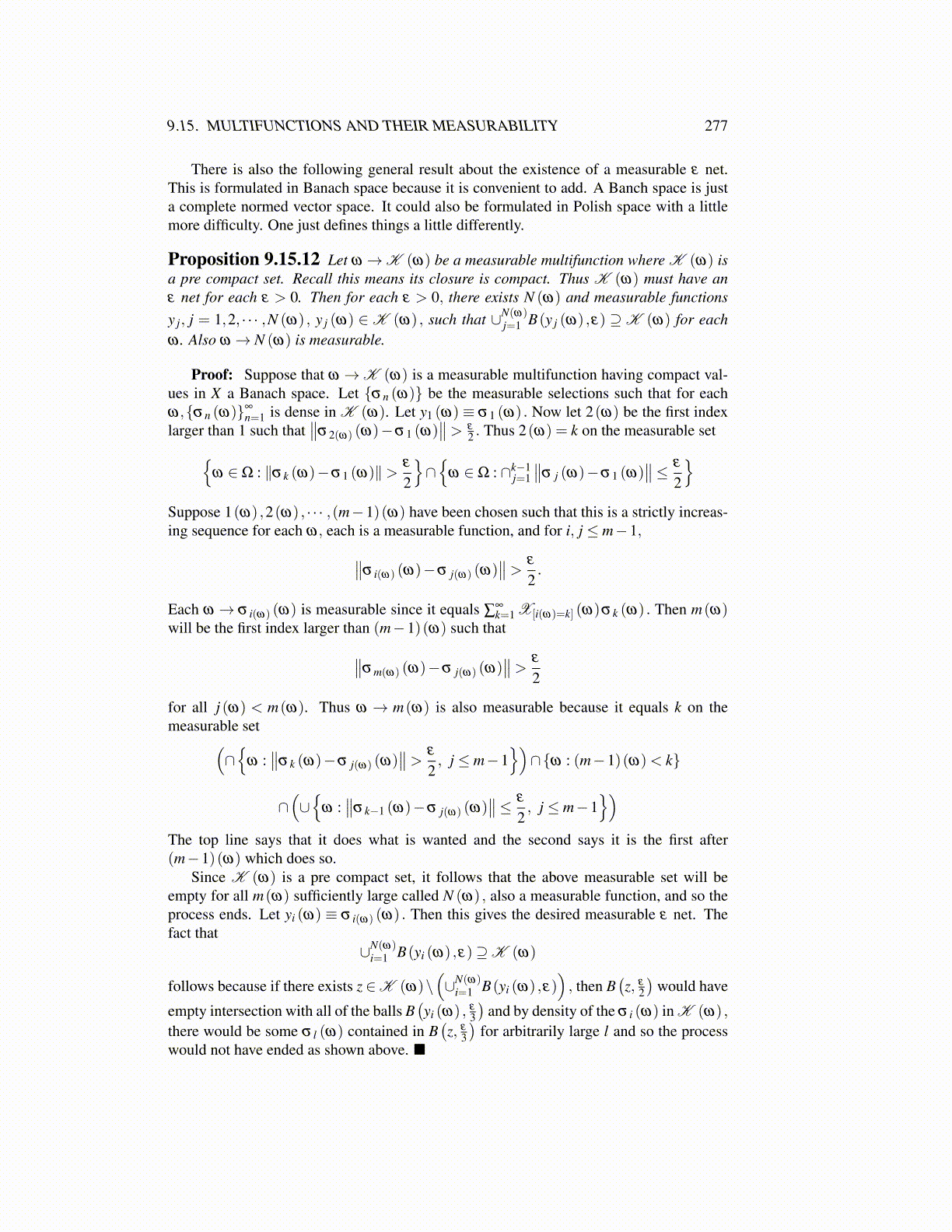
9.15. MULTIFUNCTIONS AND THEIR MEASURABILITY 277
There is also the following general result about the existence of a measurable ε net.This is formulated in Banach space because it is convenient to add. A Banch space is justa complete normed vector space. It could also be formulated in Polish space with a littlemore difficulty. One just defines things a little differently.
Proposition 9.15.12 Let ω →K (ω) be a measurable multifunction where K (ω) isa pre compact set. Recall this means its closure is compact. Thus K (ω) must have anε net for each ε > 0. Then for each ε > 0, there exists N (ω) and measurable functionsy j, j = 1,2, · · · ,N (ω) , y j (ω) ∈K (ω) , such that ∪N(ω)
j=1 B(y j (ω) ,ε) ⊇K (ω) for eachω . Also ω → N (ω) is measurable.
Proof: Suppose that ω →K (ω) is a measurable multifunction having compact val-ues in X a Banach space. Let {σn (ω)} be the measurable selections such that for eachω,{σn (ω)}∞
n=1 is dense in K (ω). Let y1 (ω) ≡ σ1 (ω) . Now let 2(ω) be the first indexlarger than 1 such that
∥∥σ2(ω) (ω)−σ1 (ω)∥∥> ε
2 . Thus 2(ω) = k on the measurable set{ω ∈Ω : ∥σ k (ω)−σ1 (ω)∥> ε
2
}∩{
ω ∈Ω : ∩k−1j=1
∥∥σ j (ω)−σ1 (ω)∥∥≤ ε
2
}Suppose 1(ω) ,2(ω) , · · · ,(m−1)(ω) have been chosen such that this is a strictly increas-ing sequence for each ω, each is a measurable function, and for i, j ≤ m−1,∥∥σ i(ω) (ω)−σ j(ω) (ω)
∥∥> ε
2.
Each ω → σ i(ω) (ω) is measurable since it equals ∑∞k=1 X[i(ω)=k] (ω)σ k (ω) . Then m(ω)
will be the first index larger than (m−1)(ω) such that∥∥σm(ω) (ω)−σ j(ω) (ω)∥∥> ε
2
for all j (ω) < m(ω). Thus ω → m(ω) is also measurable because it equals k on themeasurable set(
∩{
ω :∥∥σ k (ω)−σ j(ω) (ω)
∥∥> ε
2, j ≤ m−1
})∩{ω : (m−1)(ω)< k}
∩(∪{
ω :∥∥σ k−1 (ω)−σ j(ω) (ω)
∥∥≤ ε
2, j ≤ m−1
})The top line says that it does what is wanted and the second says it is the first after(m−1)(ω) which does so.
Since K (ω) is a pre compact set, it follows that the above measurable set will beempty for all m(ω) sufficiently large called N (ω) , also a measurable function, and so theprocess ends. Let yi (ω) ≡ σ i(ω) (ω) . Then this gives the desired measurable ε net. Thefact that
∪N(ω)i=1 B(yi (ω) ,ε)⊇K (ω)
follows because if there exists z ∈K (ω)\(∪N(ω)
i=1 B(yi (ω) ,ε)), then B
(z, ε
2
)would have
empty intersection with all of the balls B(yi (ω) , ε
3
)and by density of the σ i (ω) in K (ω) ,
there would be some σ l (ω) contained in B(z, ε
3
)for arbitrarily large l and so the process
would not have ended as shown above. ■